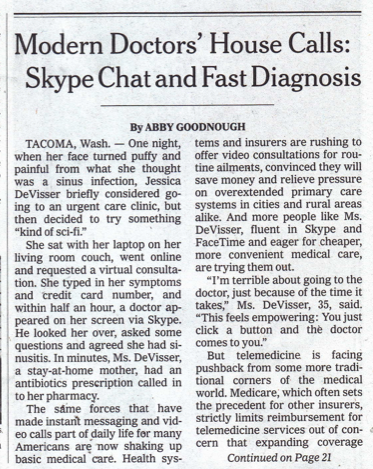A front-page story by Amy Goodnough in the New York Times July 12 discusesses the advent of Skype consultations, mainly from a financial perspective. (As Dr. Allan Frankel says, “Modern medicine is all about the billing.”)
Interestingly, Medicare is reluctant to reimburse for telemedicine consultations. The bureaucrats figure that people who now forego seeing a doctor because of the hassle and expense will avail themselves of Skype, etc.
Here’s Goodnough:
Some large insurers are starting to pay, too. UnitedHealthcare, the nation’s largest insurer, announced in April that it would cover virtual visits for most of its 26 million commercial members by next year, citing the shortage of primary care doctors and the cost of less than $50 per virtual visit. Anthem will cover virtual urgent care visits for 16 million members in 11 states by the end of this year, and it expects the number to reach 20 million next year. Both insurers are relying on third-party telemedicine companies to provide the doctors and the technology platform for the service, just as most health systems do for now.
Even as virtual visits multiply, researchers say it is not clear whether they really save money or provide better outcomes.
Virtual urgent care visits are undoubtedly less expensive than trips to the emergency room, said Dr. Ateev Mehrotra, a professor of health policy at Harvard Medical School, who has studied telemedicine.
CHI Franciscan’s virtual urgent care program contracts with Carena, a private company in Seattle that employs 17 physicians and nurse practitioners to do virtual consultations in 11 states. Among CHI Franciscan’s patients, the most frequent users are women ages 25 to 55, and the most typical diagnoses are bladder infections, upper respiratory tract infections and pinkeye.
Users are prescribed medication about 40 percent of the time, said Beth Bacon, the company’s vice president for consumer affairs. Most visits take place on weekends or between 5 p.m. and 8 a.m., she said, when doctors’ offices are closed. Like other virtual urgent care programs, CHI Franciscan’s emphasizes that it is not for medical emergencies, advising customers on its website to “call 911 or proceed to the nearest emergency room” if they have chest pain, difficulty breathing or other potentially life-threatening symptoms.
Although Carena provides all the physicians for the program now, several CHI Franciscan doctors are training to become “virtualists.” Dr. Dan Diamond, a family practitioner at one of CHI Franciscan’s urgent care centers who recently trained to conduct virtual visits, said he enjoyed the less hurried pace.
“I don’t have people knocking on the door and saying, ‘Doc, we need you in another room,’ ” he said. “I’m able to focus on that one patient, without all the commotion that happens in an urgent care or an emergency room.”
Still, he added, “there are some times where we just can’t do it virtually and we need to lay hands on a patient.”
Ms. DeVisser turned out to be one of those cases. While happy with her virtual visit last summer, she ended up going to her primary care doctor a few weeks later because the antibiotics had not fully cleared up her sinus problems. He referred her to an ear, nose and throat specialist, who found through an examination that she had nasal polyps that needed to be removed.
“At least it mitigated the problem,” she said of her video consultation. “And it was much more comfortable than having to go sit with a bunch of other sick people in a waiting room.”





